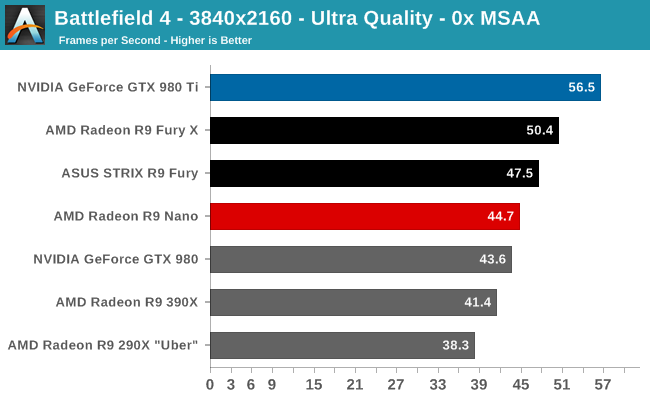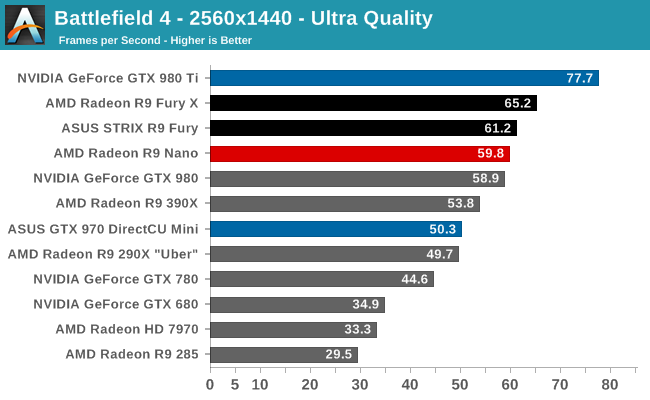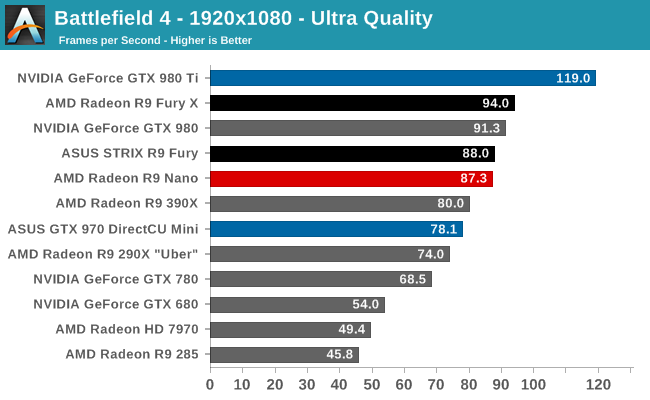The AMD Radeon R9 Nano Review: The Power of Size
by Ryan Smith on September 10, 2015 8:00 AM ESTBattlefield 4
Kicking off our benchmark suite is Battlefield 4, DICE’s 2013 multiplayer military shooter. After a rocky start, Battlefield 4 has since become a challenging game in its own right and a showcase title for low-level graphics APIs. As these benchmarks are from single player mode, based on our experiences our rule of thumb here is that multiplayer framerates will dip to half our single player framerates, which means a card needs to be able to average at least 60fps if it’s to be able to hold up in multiplayer.




Like the other Fiji cards, AMD is promoting the R9 Nano in part on its 4K capabilities. And while we disagree that this card is suitable for 4K gaming based on its sub-Fury performance, we’re including 4K results anyhow to serve as a point of comparison.
In any case Battlefield 4 is often a good indicator of general card performance, and for the R9 Nano this is no exception. What we find is that the R9 Nano trails the other Fury cards in all cases. However to our initial surprise, the R9 Nano sticks rather close to the R9 Fury. The petite powerhouse trails the R9 Fury by only 1-6%, which for the record is a smaller gap than we were expecting.
While the R9 Nano packs a full Fiji GPU, AMD has to pull back on clockspeeds to hit their power targets; in the case of Battlefield 4 this is an average clockspeed of just 879MHz at 2560x1440. Given this we had been expecting the R9 Nano to deliver around 85-90% of the performance of the R9 Fury (and about 80% of the R9 Fury X), based on the assumption that average clockspeeds would be closer to 800MHz. So the fact that the R9 Nano starts off as close to the R9 Fury as it does – even if it’s still trailing it – is a pleasant surprise.
Otherwise with performance still clearly occupying a position as a “3rd tier” Fiji card, I’m not sure if anything about these results should be surprising. On a price/performance basis AMD is not intending to be competitive with other $650 cards, so the R9 Fury X and GTX 980 Ti are of course on the top of the heap. What you get instead is a card that delivers around 90% of R9 Fury X’s performance in BF4 with much less power consumption.
Moving on, compared to the lower power and smaller cards, the R9 Nano is as expected a clean sweep. Demonstrating the virtues of a wide and lower clocked processor’s ability to deliver strong performance without requiring extreme power, everything from the R9 285 to the GTX 980 trails the R9 Nano here. Compared to the GTX 970 Mini in particular, the R9 Nano is 12-26% faster depending on the resolution.
The one potential problem here for the R9 Nano is the GTX 980. Though not a Mini-ITX card, the GTX 980’s power consumption is going to be fairly close to the R9 Nano’s, definitely more so than GTX 970’s. From a power efficiency standpoint it’s the GTX 980 that poses the greatest challenge to the R9 Nano, and while it’s ahead of the GTX 980 in this case at 2560x1440 and higher, it’s a sign that AMD should be worried about what could happen if an NVIDIA partner produced a Mini-ITX GTX 980.










284 Comments
View All Comments
LoneWolf15 - Thursday, September 10, 2015 - link
And as someone who has been a long time TR reader and has met him multiple times, I am in complete disagreement with you. His testing is some of the most detailed and accurate that I know.I have little faith in your ability to determine someone's subliminal gifts.
Kutark - Thursday, September 10, 2015 - link
Unfortunately a great many people are incapable of projecting their own biases onto someone else. Tomshardware and Anandtech have been accused of being pro one team or the other for years.I remember an article i read a few years back, i wish i could remember the guys name, but he was chief editor for one of the macintosh magazines, and he was talking about how he got so fed up with users because if he said literally anything negative about the product he would get his email inbox blown up with accusations of being a MS nutswinger, and fellating Bill Gates, and various other things. He gave an example of one of the ipods which he gave like a 90%+ review, and the ONLY negative things he said was that the casing was shiny, so it took fingerprints really well and was hard to keep looking clean, and that he wished the battery life was a little bit longer. He said he got the most vitriolic and ridiculous emails he'd ever seen.
The problem is people want confirmation that they made the right choice, and if they don't get that, then rather than admit that they made a mistake, they would rather attack the reviewer as being a fanboy or something equally hideous.
medi03 - Friday, September 11, 2015 - link
In Fermi times Anand found it "appropriate" to compare cherry picked OCed nVidia card vs stock AMD."Subtle bias" my ass.
Ryan Smith - Friday, September 11, 2015 - link
It's something we've apologized for, repeatedly. It was a poor idea and we readily admit as much.http://www.anandtech.com/show/3988/the-use-of-evga...
mapesdhs - Monday, September 14, 2015 - link
I never saw the need to apologise; the price of the FTW meant it was the far better choice to buy back then (I bought two for SLI).fuicharles - Friday, September 11, 2015 - link
I used to go to The Tech Reports to read the Top News contents everyday. Their Top News was always updated and shared lots of recent development.However, recently something fishy, Tech Reports doesn't share any news on the recent Gamesworks and Asyn Compute tragedy in their sites.
And try to pin point the Pump Whine problem even after AMD has already come up new revision of Fury Card which solve the problems.
I don't want to believe Scott Wasson is biased either, but isn't that as a journalist you should share the bad/good for both camp to let the readers judge themselves
milli - Friday, September 11, 2015 - link
'most detailed and accurate' ≠ unbiasedDon't worry that you didn't notice the hidden bias. It took me a while to realize it. After reading TR for a couple years, around 2006 I started noticing the bias. It's not what he says that's biased but what he doesn't say/report that makes him biased. He's smart.
Well he's getting better at hiding his bias these last years. In the previous decade he would often pit OC'd nVidia cards with stock AMD cards in his 'reviews'.
Just like many knew that Anand was biased towards Apple with his ridiculously positive reviews until the final proof came when he went to actually work for them.
slickr - Saturday, September 12, 2015 - link
He has been shilling for Nvidia for good several years now, everything Nvidia does = great, amazing, unique, always winning in some ultra specific aspect even if realistically the card is garbage, when he talks about AMD = power consumption is 10W or 20W more than Nvidia, Nvidia clear winner, price and performance don't matter, only those 10W difference matters.No way for AMD to win, I would have not sent review copies to a whole more websites, there are at least 4-5 of top of my head that are Nvidia shill town and they not even doing it subtly.
althaz - Monday, September 14, 2015 - link
nVidia have had a lead in performance for half a decade or more now - it's not tech reviewers fault that AMD are using more power to deliver worse performance at similar prices.chrnochime - Saturday, September 12, 2015 - link
And we're suppose to have faith in YOUR view of SW? LOL